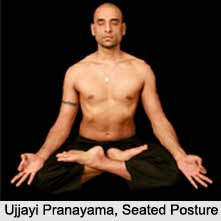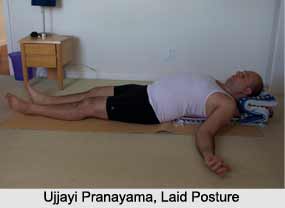 "Pranayama" in Sanskrit is a yoga breathing exercise essential to develop a deep and thorough yoga practice. Amongst the wide varieties of Pranayama that are popular throughout India, the "Ujjayi Pranayama" is a prominent one. Pranayama is one of the classical Eight Limbs of Yoga, according to the "Yoga Sutras", the ancient yoga text compiled by the sage Patanjali. There are about 70 types of Pranayama mentioned in the traditional texts. These breathing techniques in addition to deepening the yoga practice, calm and invigorate the body and the spirit, benefiting life of the mat. The Ujjayi Pranayama is one such exercise that calms the mind and warms the body. The technique involves breathing deeply through the nose, slightly contracting the throat and filling the lungs completely. It is widely used in Ashtanga and Vinyasa yoga practices. In the Ashtanga yoga, Ujjayi Pranayama is mentioned as the archetypal yoga breathing practice of controlling "prana", the life force, through paused breath.
"Pranayama" in Sanskrit is a yoga breathing exercise essential to develop a deep and thorough yoga practice. Amongst the wide varieties of Pranayama that are popular throughout India, the "Ujjayi Pranayama" is a prominent one. Pranayama is one of the classical Eight Limbs of Yoga, according to the "Yoga Sutras", the ancient yoga text compiled by the sage Patanjali. There are about 70 types of Pranayama mentioned in the traditional texts. These breathing techniques in addition to deepening the yoga practice, calm and invigorate the body and the spirit, benefiting life of the mat. The Ujjayi Pranayama is one such exercise that calms the mind and warms the body. The technique involves breathing deeply through the nose, slightly contracting the throat and filling the lungs completely. It is widely used in Ashtanga and Vinyasa yoga practices. In the Ashtanga yoga, Ujjayi Pranayama is mentioned as the archetypal yoga breathing practice of controlling "prana", the life force, through paused breath.
Etymology of Ujjayi Pranayama
The word "Ujjayi" is a concoction of Sanskrit words `ud` and `jayi` which together mean "to be victorious" or "to conquer". "Pranayama" is formed by two words "prana" which means life force, particularly breath, and "ayama", which refers to extend or draw out, thus signifying extension of breath. Quite ideally therefore, in Ujjayi Pranayama, the lungs of the practitioner are fully expanded as that of a mighty conqueror. It is also often referred to as "victorious breath." Given the sound it makes when performed correctly, this breath is also sometimes called the "ocean breath" or "hissing breath". Many yoga teachers simply refer to it as "Ujjayi breath".
Technique of Ujjayi Pranayama
Ujjayi Pranayama is a diaphragmatic breathing technique, first filling the lower belly, activating the first and second "chakras" (energy points or nodes in a subtle body, one of a series of psycho-spiritual elements of living beings), rising to the lower rib cage to activate the third and fourth "chakras" and finally up to the upper chest and throat. Unlike some other forms of Pranayama, the Ujjayi breath is typically performed with "asana" (the place and posture while practising yoga) practice. The distinct exercise aids in stretching the breath whilst warming it, by prior letting it into the lungs and therefore heating the body. The 3 breathing techniques of "Puraka", "Kumbhaka" and "Rechaka" form the wholesome process of Ujjayi Pranayama.
Puraka: The process of single inhalation has been termed as Puraka. In Ujjayi Pranayama, Puraka is therefore the act of inhalation through the nose, where the "ocean sound" is created by moving the glottis as air passes in. As the throat passage is narrowed and thus, so is the airway, the passage of air through which creates a hissing sound.
Kumbhaka: In Pranayama, Kumbhaka stands for a particular breathing technique. The apt process of suspension and retention of breath is the key element in Kumbhaka, performed while inhalation, termed as "Antara Kumbhaka" (retaining the air after slightly forceful inhalation, thus filling the lungs with more air than normal) as well as exhalation, termed as "Bahya Kumbhaka" (suspending the breath after exhaling more air than normal).
Rechaka: The Rechaka in Pranayama deals with exhalation which is lengthened, performed by relaxing the expanded chest after retention of inhaled air, breathing it out and thereafter suspending the breath.
 In the old "Hatha Yoga" text, a reference of the Ujjayi Pranayama can be found. In the performing technique of Ujjayi Pranayama, `Kumbhaka` is considered a necessary prior practice. Authentically, Puraka, Kumbhaka and Rechaka need to be practised before performing the Ujjayi Pranayama. These are nothing but extremely controlled breathing technique through the nose.
In the old "Hatha Yoga" text, a reference of the Ujjayi Pranayama can be found. In the performing technique of Ujjayi Pranayama, `Kumbhaka` is considered a necessary prior practice. Authentically, Puraka, Kumbhaka and Rechaka need to be practised before performing the Ujjayi Pranayama. These are nothing but extremely controlled breathing technique through the nose.
Steps for Ujjayi Pranayama
The Ujjayi Pranayama can be performed in the following manner.
1. Sitting in a comfortable posture, such as "sukhasana" or Easy Pose, keeping the spine erect.
2. Inhaling slowly while drawing the air in through both the nostrils, in such a way that the touch of air is felt in the throat and a faint sound is produced. During inhalation while expanding the chest, the abdomen should not bulge out.
3. Retention of air to fill the lungs and heat the body.
4. Slow and stretched exhalation after retaining the air, breathing it out in full. During exhalation, the chest is relaxed and the abdomen steady.
The length and speed of the breath is controlled by the diaphragm, the strengthening of which is a part purpose of Ujjayi Pranayama. The inhalations and exhalations are equal in duration and controlled in a manner that causes no distress to the practitioner.
Benefits of Ujjayi Pranayama
By maintaining a steady and rhythmic breath, one calms the mind and brings awareness to the present moment. This very awareness forms the core of yoga. In yoga, it is believed that by consciously practising breath control exercises, one can bring positive changes to physical, mental, emotional and spiritual wellbeing. Ujjayi Pranayama, with controlled, extended and deep breath as its very essence, enriches and deepens the yoga practice. The steady, deep and resonating Ujjayi breath practised in every posture throughout the yoga practice, body seated or lying down, brings the body, mind and spirit together to focus into the very moment. The physical practice is strengthened with extra oxygen inhaled and deeply exhaled, also invigorating the spirit and helping in venting out restrained emotions. It calms the practitioner mentally, relieving from stress, anxiety and insomnia.
The Ujjayi Pranayama is also beneficial from the health point of view, with its balancing breath that increases oxygenation and builds internal body heat. It fills oxygen in all parts of the lungs, with free and healthy passage. It regulates blood pressure and removes the bodily toxins. It also helps in relieving respiratory problems like asthma.
Precautions during Ujjayi Pranayama
Few precautions need to be taken care of while practising Ujjayi Pranayama, such as:
•Being careful of not tightening the throat while inhalation.
•Not attempting such breathing exercise without the guidance of a trainer for the first time, particularly when suffering from any respiratory disorder such as asthma or emphysema.
•Stopping the exercise if dizziness or feeling of losing consciousness creeps in.
•Working within one"s own range of limits and ability.
•Consulting a doctor prior to practice in case of any medical concern.




















